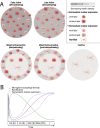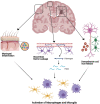Central nervous system macrophages in progressive multiple sclerosis: relationship to neurodegeneration and therapeutics
- PMID: 35144628
- PMCID: PMC8830034
- DOI: 10.1186/s12974-022-02408-y
Central nervous system macrophages in progressive multiple sclerosis: relationship to neurodegeneration and therapeutics
Abstract
There are over 15 disease-modifying drugs that have been approved over the last 20 years for the treatment of relapsing-remitting multiple sclerosis (MS), but there are limited treatment options available for progressive MS. The development of new drugs for the treatment of progressive MS remains challenging as the pathophysiology of progressive MS is poorly understood.The progressive phase of MS is dominated by neurodegeneration and a heightened innate immune response with trapped immune cells behind a closed blood-brain barrier in the central nervous system. Here we review microglia and border-associated macrophages, which include perivascular, meningeal, and choroid plexus macrophages, during the progressive phase of MS. These cells are vital and are largely the basis to define lesion types in MS. We will review the evidence that reactive microglia and macrophages upregulate pro-inflammatory genes and downregulate homeostatic genes, that may promote neurodegeneration in progressive MS. We will also review the factors that regulate microglia and macrophage function during progressive MS, as well as potential toxic functions of these cells. Disease-modifying drugs that solely target microglia and macrophage in progressive MS are lacking. The recent treatment successes for progressive MS include include B-cell depletion therapies and sphingosine-1-phosphate receptor modulators. We will describe several therapies being evaluated as a potential treatment option for progressive MS, such as immunomodulatory therapies that can target myeloid cells or as a potential neuroprotective agent.
Keywords: Macrophages; Microglia; Multiple sclerosis; Neurodegeneration; Primary progressive; Secondary progressive; Therapeutics.
© 2022. The Author(s).
Conflict of interest statement
The authors declare no competing interests with this work.
Figures




Similar articles
-
Neuronal injury in chronic CNS inflammation.Best Pract Res Clin Anaesthesiol. 2010 Dec;24(4):551-62. doi: 10.1016/j.bpa.2010.11.001. Epub 2010 Nov 29. Best Pract Res Clin Anaesthesiol. 2010. PMID: 21619866 Review.
-
Siponimod for the treatment of secondary progressive multiple sclerosis.Expert Opin Pharmacother. 2019 Feb;20(2):143-150. doi: 10.1080/14656566.2018.1551363. Epub 2018 Dec 5. Expert Opin Pharmacother. 2019. PMID: 30517042 Review.
-
Targeting B Cells and Microglia in Multiple Sclerosis With Bruton Tyrosine Kinase Inhibitors: A Review.JAMA Neurol. 2023 Apr 1;80(4):404-414. doi: 10.1001/jamaneurol.2022.5332. JAMA Neurol. 2023. PMID: 36780171 Review.
-
Parenchymal accumulation of CD163+ macrophages/microglia in multiple sclerosis brains.J Neuroimmunol. 2011 Aug 15;237(1-2):73-9. doi: 10.1016/j.jneuroim.2011.06.006. Epub 2011 Jul 6. J Neuroimmunol. 2011. PMID: 21737148
-
Sphingosine 1-Phosphate Receptor Modulators for Multiple Sclerosis.CNS Drugs. 2021 Apr;35(4):385-402. doi: 10.1007/s40263-021-00798-w. Epub 2021 Apr 2. CNS Drugs. 2021. PMID: 33797705 Review.
Cited by
-
Small-molecule targeting AMPA-mediated excitotoxicity has therapeutic effects in mouse models for multiple sclerosis.Sci Adv. 2023 Dec 8;9(49):eadj6187. doi: 10.1126/sciadv.adj6187. Epub 2023 Dec 8. Sci Adv. 2023. PMID: 38064562 Free PMC article.
-
Alleviating early demyelination in ischaemia/reperfusion by inhibiting sphingosine-1-phosphate receptor 2 could protect visual function from impairment.Brain Pathol. 2023 Sep;33(5):e13161. doi: 10.1111/bpa.13161. Epub 2023 May 4. Brain Pathol. 2023. PMID: 37142391 Free PMC article.
-
Brain organoid methodologies to explore mechanisms of disease in progressive multiple sclerosis.Front Cell Neurosci. 2024 Dec 18;18:1488691. doi: 10.3389/fncel.2024.1488691. eCollection 2024. Front Cell Neurosci. 2024. PMID: 39744673 Free PMC article. Review.
-
Modulation of NCX1 expression in monocytes associates with multiple sclerosis progression.Heliyon. 2025 Jan 30;11(4):e42332. doi: 10.1016/j.heliyon.2025.e42332. eCollection 2025 Feb 28. Heliyon. 2025. PMID: 40041001 Free PMC article.
-
Differences of the 6N and 6J Substrains of C57BL/6 Mice in the Development of Experimental Autoimmune Encephalomyelitis.MedComm (2020). 2025 Jul 2;6(7):e70228. doi: 10.1002/mco2.70228. eCollection 2025 Jul. MedComm (2020). 2025. PMID: 40606779 Free PMC article.
References
-
- Cunniffe N, Vuong KA, Ainslie D, Baker D, Beveridge J, Bickley S, Camilleri P, Craner M, Fitzgerald D, de la Fuente AG, et al. Systematic approach to selecting licensed drugs for repurposing in the treatment of progressive multiple sclerosis. J Neurol Neurosurg Psychiatry. 2021;92:295–302. - PubMed
Publication types
MeSH terms
LinkOut - more resources
Full Text Sources
Medical

